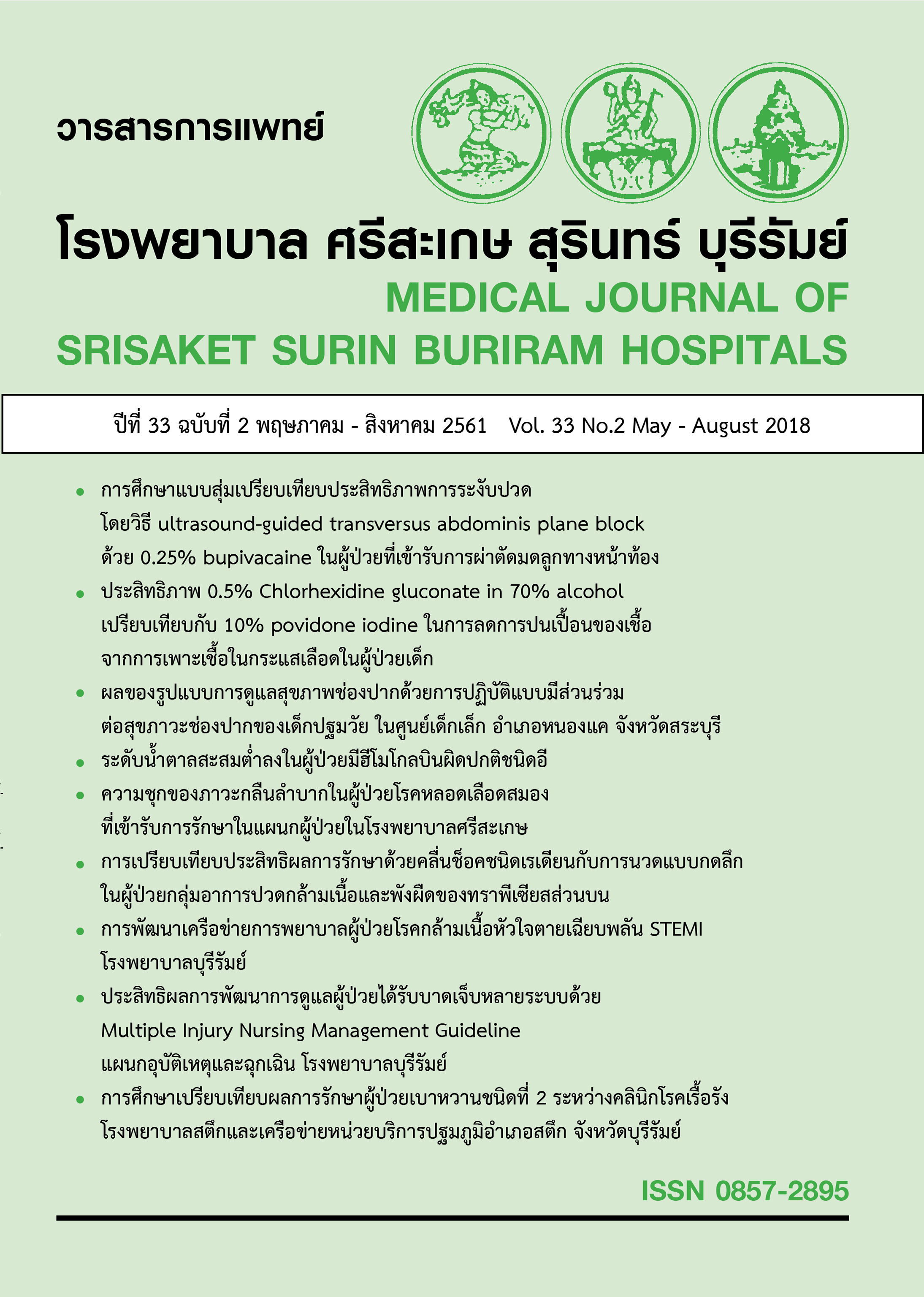ระดับน้ำตาลสะสมต่ำลงในผู้ป่วยมีฮีโมโกลบินผิดปกติชนิดอี
Main Article Content
บทคัดย่อ
หลักการและเหตุผล: อายุของเม็ดเลือดแดงมีผลต่อการวัดระดับน้ำตาลสะสม การศึกษานี้มีเป้าหมายในการศึกษาความสัมพันธ์ระหว่างระดับของน้ำตาลสะสมและระดับน้ำตาลในพลาสม่าขณะอดอาหารในผู้ป่วยเบาหวานที่มีภาวะฮีโมโกลบินผิดปกติ
วิธีการศึกษา: การศึกษาแบบภาคตัดขวาง รวบรวมข้อมูลตั้งแต่ปี พ.ศ. 2552-2560 ประกอบด้วยข้อมูลทั่วไป ระดับน้ำตาลในพลาสม่าขณะอดอาหารมากกว่า 6 ชั่วโมง เปรียบเทียบกับระดับน้ำตาลสะสม โดยแบ่งกลุ่มผู้ป่วยเป็น 3 กลุ่มตาม ผลการตรวจการคัดกรองภาวะฮีโมโกลบินผิดปกติชนิดอี ประกอบด้วยกลุ่มควบคุม กลุ่มฮีโมโกลบินผิดปกติชนิดแฝงและกลุ่มฮีโมโกลบินผิดปกติชนิดอีอี ในแต่ละกลุ่มแบ่งระดับน้ำตาลสะสมเป็นกลุ่มย่อย อีก 6 กลุ่ม โดยมีสมมุติฐานว่าที่ค่าเฉลี่ยระดับน้ำตาลสะสมเท่ากันค่าเฉลี่ยของระดับน้ำตาลในพลาสม่าก็ควรจะเท่ากันด้วย หากภาวะของฮีโมโกลบินผิดปกติไม่มีผลต่อการวัดระดับน้ำตาลสะสม
ผลการศึกษา: ผู้ป่วยเบาหวานได้รับการเจาะเลือดทั้งหมด 1947 ครั้ง กลุ่มควบคุม 725 ครั้ง กลุ่มฮีโมโกลบินผิดปกติ 1222 ครั้ง ข้อมูลทั่วไปไม่แตกต่างกัน ค่าเฉลี่ยของอายุ ระดับน้ำตาลสะสม ระดับน้ำตาลในพลาสม่า ไม่แตกต่างกัน แต่ผู้ป่วยฮีโมโกลบินผิดปกติมีภาวะซีดมากกว่า จากการแบ่งกลุ่มผู้ป่วยเป็น 6 กลุ่ม ข้อมูลผู้ป่วยส่วนใหญ่ อยู่ในกลุ่ม 6.0-6.4, 6.4-6.9 และ 7.0-7.4 จากการทดสอบด้วยอโนว่า ที่ระดับน้ำตาลสะสมเท่ากันนั้น ระดับน้ำตาลในพลาสม่ายังคงสูงกว่า โดยเฉพาะในกลุ่มฮีโมโกลบินอีอี แต่ในกลุ่มที่ระดับน้ำตาลสะสมสูงมากหรือต่ำมาก ไม่มีความแตกต่างกัน ส่วนกลุ่มฮีโมโกลบินอีชนิดแฝง มีความแตกต่าง ที่ระดับน้ำตาลสะสมเท่ากัน ระดับน้ำตาลในพลาสม่ายังคงสูงในกลุ่มระดับน้ำตาลสะสมร้อยละ 6.0-6.4 และ ร้อยละ 6.5-6.9
สรุป: การใช้ระดับน้ำตาลสะสมในการประเมินการควบคุมระดับน้ำตาลในเลือดในผู้ป่วยเบาหวานที่มีฮีโมโกลบินผิดปกติชนิดอี ควรแปลผลด้วยความระมัดระวัง ที่ระดับน้ำตาลสะสม ร้อยละ 6.0-7.5 นั้นระดับน้ำตาลในพลาสม่าขณะอดอาหารยังคงสูง เพราะผลต่ำลวงในการวัดระดับน้ำตาลสะสม
คำสำคัญ: เบาหวาน น้ำตาลสะสม น้ำตาลเฉลี่ย ฮีโมโกลบินผิดปกติ ทัลลัสซีเมีย
Article Details
เอกสารอ้างอิง
2. Selvin E, Marinopoulos S, Berkenblit G, et al. Meta-analysis: glycosylated hemoglobin and cardiovascular disease in diabetes mellitus. Ann Intern Med. 2004;141:421-31.
3. Rohlfing CL, Wiedmeyer HM, Little RR, England JD, Tennill A, Goldstein DE: Defining the relationship between plasma glucose and HbA(1c): analysis of glucose profiles and HbA(1c) in the Diabetes Control and Complications Trial. Diabetes Care. 2002;25:275-8.
4. American Diabetes Association: Standards of medical care in diabetes 2017. Diabetes care. 2017;9:320-24.
5. Schulz KF, Grimes DA. Multiplicity in randomised trials. Endpoints and treatments. Lancet. 2005;365:1591-95.
6. Sacks DB, Bruns DE, Goldstein DE, Maclaren NK, McDonald JM, Parrott M: Guidelines and recommendations for laboratory analysis in the diagnosis and management of diabetes mellitus. Clin Chem. 2002;48:436-72.
7. The Action to Control Cardiovascular Risk in Diabetes (ACCORD) Study Group. Effects of intensive glucose lowering in type 2 diabetes. N Engl J Med. 2008;358:2545-59.
8. Bunn HF, Haney DN, Kamin S, Gabbaj KH, Gallop PM. The biosynthesis of human he-moglobin A1c. J Clin Invest. 1976;41:1652-9.
9. Fitzgibbons JF, Koler RD, Jones RT. Red-cell age-related changes of hemoglobins A1a+b and A1c in normal and diabetic subjects. J Clin Invest. 1976;41:820-4.
10. Weykamp CW, Penders TJ, Muskiet FA, van der Slik W: Influence of hemoglobin va-riants and derivatives on glycohemoglobin determinations, as investigated by 102 la-boratories using 16 methods. Clin Chem. 39;1993:1717-23.
11. Sueyunyongsiri P. Effect of Hemoglobin E disorder on Hemoglobin A1c in Diabetic patients. Med J Srisaket Surin Buriram Hosp. 2008;23:637-43.
12. Schneider RG, Hightower B, Hosty TS, Ryder H, Tomlin G, Atkins R, Brimhall B, Jones R. Abnormal hemoglobins in a quarter million people. Blood. 1976;48:629-37.
13. Weatherall DJ, Clegg JB. Inherited haemoglobin disorders: an increasing global health problem. Bulletin of the World Health Organization. 2001;79:704-12.
14. Fucharoen S, Winichagoon P. Hemoglobinopathies in Southeast Asia. Hemoglobin. 1987;11:65-88.
15. Na-Nakorn S, Wasi P. The distribution of hemoglobin E : hemoglobin E triangle in Southeast Asia. J Med Assoc Thai. 1972;61:65-8.
16. Sattarattanamai C, Thongsuk S, Sutjaritchep P, Thuengsang D, Chomchuen S: Preva-lence of thalassemia and hemoglobinopathies in pregnant women at Surin Hospital. Med J Srisaket Surin Buriram Hosp. 2000;15:1-12.
17. Srisurin W. Prevalence and effect of hemoglobin E disorders on Hba1c and lipid pro-file of diabetic patients at Surin Hospital. J Med Assoc Thai. 2011;94:36-41.
18. Fucharoen G, Sanchaisuriya K, Sae-ung N, Dangwibul S, Fucharoen S. A simplified screening strategy for thalassaemia and haemoglobin E in rural communities in south-east Asia. Bull World Health Organ. 2004;82:364-72.


